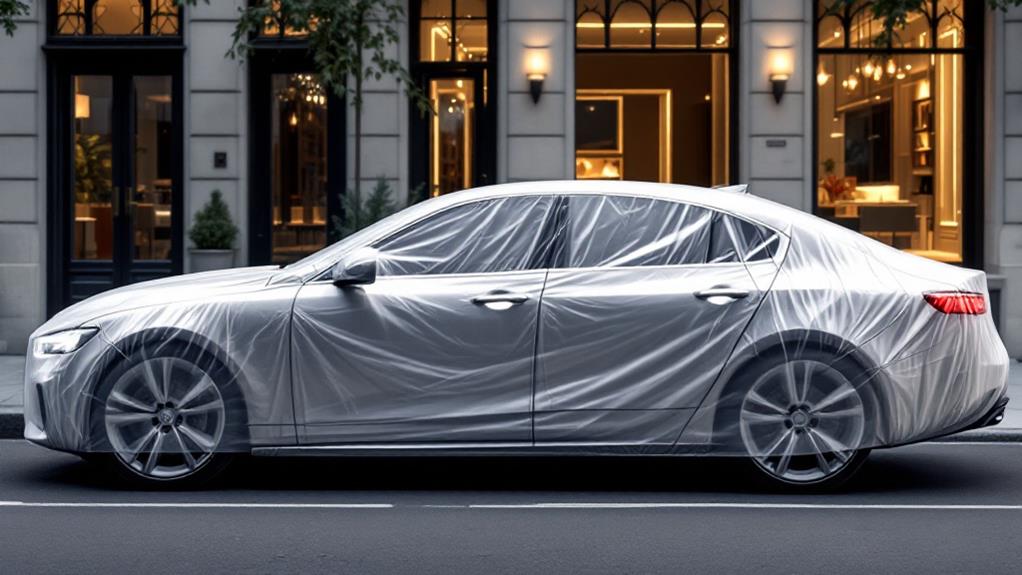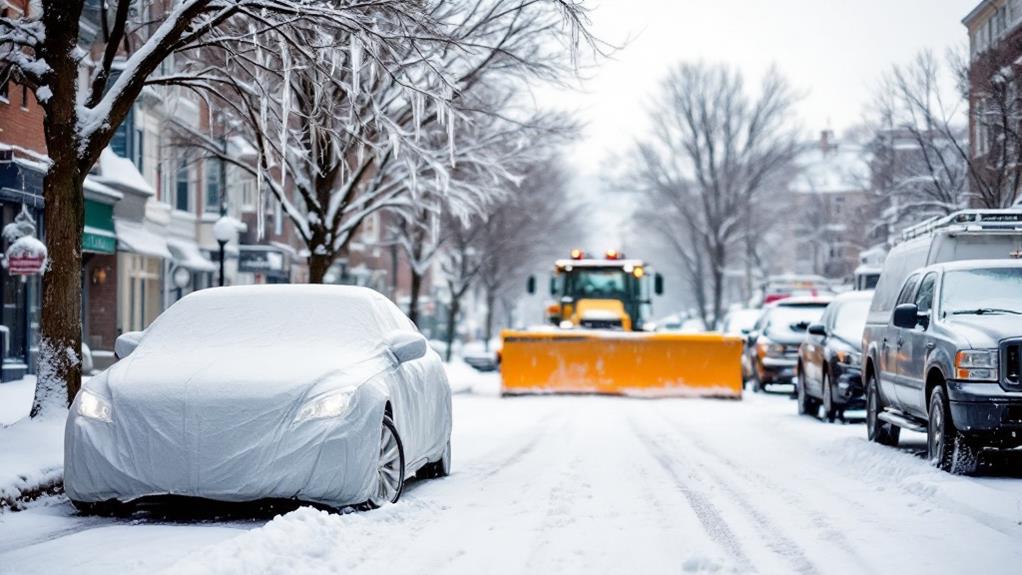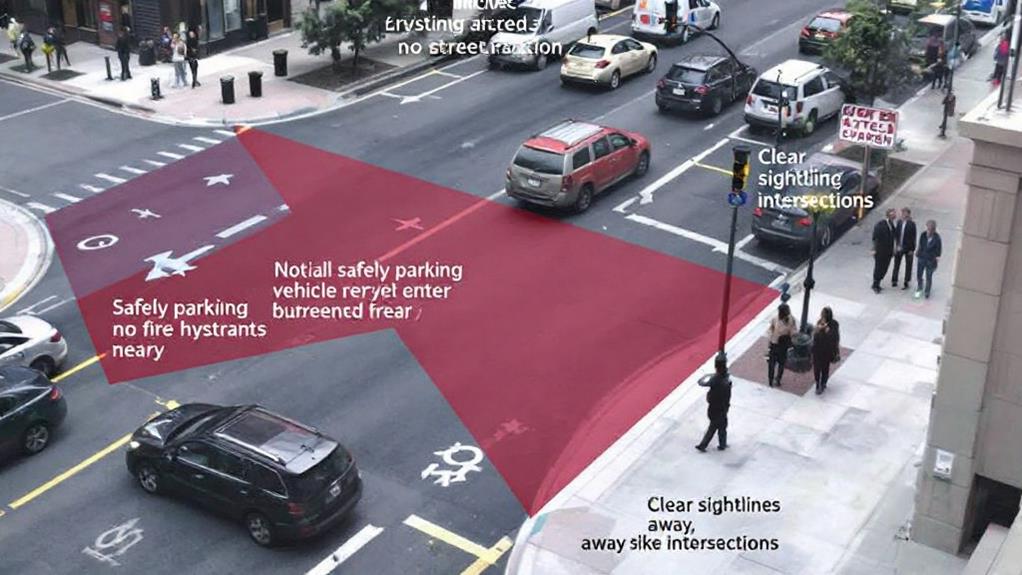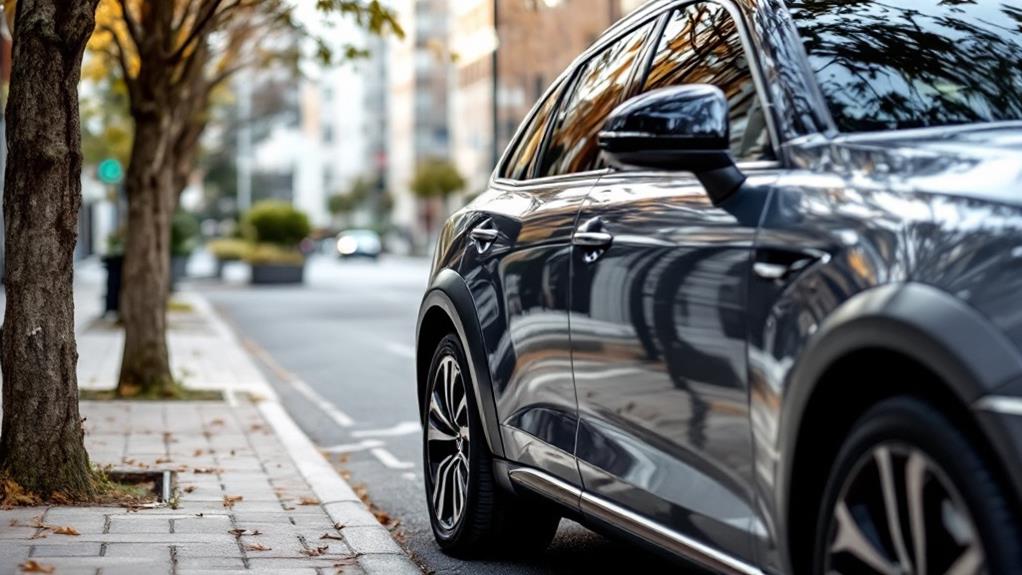Street Parking and Weather: How to Keep Your Car Safe

When street parking, choose well-lit spots near busy areas and check for parking restrictions. Protect your car from sun damage with window shades and regular waxing. Shield against rain and hail by using a durable car cover and seeking covered parking when possible. For winter, research parking rules and keep a snow shovel handy. Always lock your vehicle, engage security features, and avoid leaving prized possessions visible. Install protective accessories like UV-blocking sunshades and bug screens. Monitor weather forecasts to anticipate and prepare for severe conditions. By implementing these strategies, you'll markedly diminish the risks associated with street parking and keep your car safer in various weather conditions. There's more to uncover about safeguarding your vehicle.
Choose the Right Parking Spot
Choosing the right parking spot is essential for keeping your car safe when street parking. When you're looking for a place to park, opt for brightly lit areas near businesses or other active establishments. These spots offer increased visibility and foot traffic, deterring potential thieves and vandals. Avoid secluded side streets or alleys, as they make your vehicle an easier target.
Before settling on a parking spot, check for any signs indicating parking restrictions, towing zones, or snow emergencies. This precaution can save you from costly tickets or the hassle of retrieving a towed vehicle. Look for parking spots with ample space on both sides, allowing for easy entry and exit while reducing the risk of door dings or scratches.
If you're not confident in your parallel parking skills or have a larger vehicle, choose a spot that accommodates your car's size and your abilities. Busy streets often have more parking options, but they may require more maneuvering. Consider your vehicle's dimensions and your comfort level when selecting a spot. By following these guidelines, you'll increase your chances of finding a safe and convenient parking spot for your car.
Protect Against Sun Damage
Countless car owners underestimate the damage that prolonged sun exposure can inflict on their vehicles. The sun's UV rays can cause extensive harm to both your car's exterior and interior, leading to fading, cracking, and deterioration. To protect against sun damage, you'll need to take proactive measures.
Start by using window shades or sunscreens to block harmful UV rays from entering your car. These simple tools can effectively shield your upholstery, dashboard, and other interior components from sun-related wear. For thorough protection when parked, invest in a high-quality car cover designed for outdoor use. This will safeguard your entire vehicle from the sun's damaging effects.
Don't neglect your car's exterior. Regular car washes and waxing sessions help maintain your paint and provide an additional layer of protection against sun damage. Consider applying a UV-resistant sealant or tint to your windows for extra interior safeguarding. By implementing these strategies, you'll drastically reduce the risk of sun-induced deterioration and maintain your car's appearance and value over time. Remember, consistent care is key to keeping your vehicle looking its best, even when faced with harsh sunlight during street parking.
Shield From Rain and Hail

Rain and hail can wreak havoc on your car's exterior, causing damage that's both costly and unsightly. To protect your vehicle from severe weather, invest in a high-quality car cover. Look for one that's durable and waterproof, with reinforced stitching and straps to withstand strong winds. This will shield your car's exterior from precipitation and potential hail damage.
When possible, park in a covered garage or carport to completely protect your vehicle from rain and hailstorms. If you don't have access to covered parking, keep an eye on weather forecasts and prepare accordingly. When severe weather is expected, take these precautions:
- Install your car cover before the storm hits
- Seek out temporary covered parking options
- Move your car to a safer location if possible
Prepare for Winter Conditions
While protecting your car from rain and hail is important, winter conditions present a unique set of challenges for street parking. To prepare for winter, start by researching your city's overnight parking and alternate-side parking rules. Winter parking regulations often change, so stay informed to avoid tickets.
Keep a snow shovel in your vehicle to dig out after plows pass through. Be mindful of where you discard snow to prevent blocking other cars or violating local ordinances. Use map apps to drop a pin at your parking location, making it easier to find your car after heavy snowfall obscures landmarks.
Set calendar alerts for street sweeping and changing parking regulations during winter months. This will help you stay on top of any temporary restrictions or required vehicle movements. By planning ahead and staying informed, you'll be better equipped to handle winter conditions and protect your car from potential damage or fines.
Secure Your Vehicle

Securing your vehicle is critical when parking on the street. To keep your car safe and protect it from theft and damage, take these precautions:
- Lock all doors and windows securely
- Engage the steering wheel lock
- Use a car cover to shield the exterior
When you park your car, choose well-lit areas near businesses with security cameras. This heightened visibility deters criminal activity and reduces the risk of theft. Don't leave valuables in plain sight, as this tempts thieves. Instead, store them in the trunk or glove compartment.
A car cover is an excellent investment to protect your vehicle from sun damage, debris, and weather elements. It also makes your car less appealing to potential thieves, as it requires more time and effort to remove.
Remember to take your keys with you and never leave them in the car, even if you're just stepping away for a moment. By following these simple steps, you'll drastically reduce the risk of theft and damage to your vehicle when parking on the street. Stay vigilant and prioritize your car's security to guarantee peace of mind while it's parked.
Maintain Regular Cleaning Schedule
Beyond securing your vehicle, maintaining a regular cleaning schedule is key to protecting your car from environmental damage when parked on the street. Make it a habit to wash your car every two weeks, or more often during harsh weather conditions. This routine will help prevent paint and finish damage caused by prolonged exposure to the elements.
When you clean your car, use a high-quality car wash solution and microfiber cloths to keep the exterior scratch-free. After washing, apply a protective wax or sealant to create a barrier against environmental hazards like bird droppings and tree sap. If you park your car on the street, look closely for any spots that need immediate attention, such as bug splatter or bird droppings, and clean them promptly to avoid permanent staining.
Don't forget to clean the undercarriage regularly, especially during winter, to remove corrosive materials like salt and mud. For added protection, consider using a car cover when you park your car on the street. This extra layer of defense will help safeguard your vehicle from weather-related damage and make sure your car stays in top condition, even when exposed to the elements.
Install Protective Accessories

In addition to regular cleaning, installing protective accessories can greatly enhance your car's defense against the elements during street parking. A high-quality car cover is your first line of defense, shielding your vehicle from sun damage, hail, and falling debris. Water-resistant covers offer superior protection against rain and snow, ensuring your car remains safe in severe weather conditions.
Don't overlook the importance of smaller accessories. Bug screens prevent insect buildup and paint damage, while sunshades effectively block UV rays and reduce interior heat buildup. These simple additions can considerably extend your car's lifespan and maintain its appearance.
When investing in car accessories for weather protection, consider these key items:
- A durable, water-resistant car cover
- UV-blocking sunshades for windows
- Bug screens for the front grille and headlights
Monitor Weather Forecasts
While protective accessories offer a solid defense, staying informed about weather conditions is equally important for safeguarding your street-parked vehicle. To do this effectively, you'll need to monitor weather forecasts regularly. Keep an eye out for alerts about potential storms, temperature changes, and severe weather that could impact your car.
Be particularly vigilant for warnings about hail, heavy rain, or heavy snow, as these can cause significant damage to your vehicle. Extreme temperature swings can also affect your car's components and interior, so stay aware of these fluctuations. Pay close attention to forecasts for high winds, which may blow debris onto your parked car and cause dents or scratches.
Don't forget to watch for flash flood warnings, especially if you're parked in a low-lying area. Sudden inundations can submerge your vehicle, leading to extensive damage. By staying informed about upcoming weather events, you'll be better prepared to take action and move your car to a safer location if necessary. Remember, consistent monitoring of weather forecasts is key to protecting your street-parked vehicle from nature's unpredictable forces.
Consider Seasonal Parking Strategies

Savvy car owners know that adapting their parking strategies to the changing seasons is crucial for protecting their vehicles. As the weather shifts throughout the year, you'll need to adjust your approach to parking your car. In summer, use sun shades and car covers to shield your vehicle's interior from UV damage and excessive heat buildup. When autumn arrives, be cautious about parking under trees, as falling leaves and sap can harm your car's paint and finish.
Winter brings its own challenges, so prepare for snow and ice by keeping these essentials in your car:
- A shovel
- An ice scraper
- Sand or kitty litter for traction
Choose parking spots that are easier to dig out and consider using covered garages during hail or snowstorms to protect your car's exterior. In spring and during heavy rain, be mindful of potential flooding risks and park on higher ground when possible.
Year-round, remember that where you park can affect your car's safety and condition. Avoid areas with a high risk of theft, and always be aware of how the weather might impact your parking choice to keep your vehicle in top shape.
Implement Anti-Theft Measures
Protecting your car from theft is just as important as shielding it from the elements. To keep your car safe when parked on the street, implement these anti-theft measures. First, install a steering wheel lock or brake pedal lock. These visible deterrents make your car less appealing to thieves and can prevent even the most determined criminals.
Next, use a security decal or flashing light to indicate your car's protected by an alarm system. This visual cue often discourages potential thieves. For added security, engrave your vehicle identification number (VIN) on major components. This makes your car less attractive to parts thieves and easier to identify if stolen.
Consider installing a GPS tracking device to aid in recovery if your car sticks out to thieves. While car covers minimize sun damage, they can also conceal suspicious activity. If you use one, choose a model that allows for easy visual inspection.



